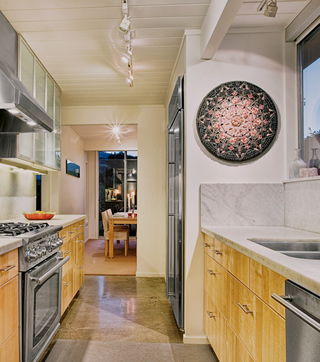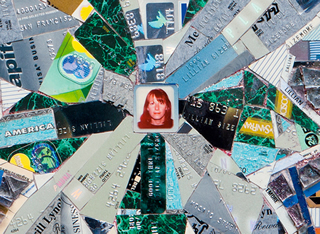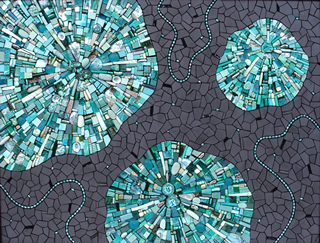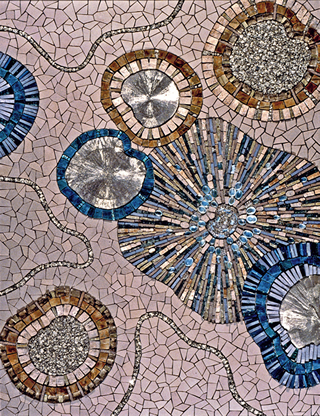Art Goes to Pieces - Page 5
In 1967, in their book Modern Mosaic Techniques, Janice Lovoos, a close friend of Sheets, and co-author Felice Paramore focused on yet another revival, this one including such novel materials for mosaic as scrap wood, packaged pasta, and nails.
The book featured work by Emile Norman, “credited with being the first to use natural leaves and foliage between two sheets of Plexiglas, a variety of the mosaic technique which he has named Endomosaic.” One of his pieces included the skeleton of a fish.
Norman, a largely self-taught artist who lived in a self-built home in Big Sur, created one of San Francisco’s greatest and most unusual mosaic installations—the 38-by-48-foot window at the Masonic Center atop Nob Hill, from the late 1950s.
The work, which shows the Masons’ all-seeing eye above scenes of miners and sailors, wagon trains, and airplanes, is composed of glass, acrylic, metal, fabric, shells, earth, and more, sandwiched between plastic panels for an effect suggesting stained glass.
 |
|
|
 |
|
|
 |
|
|
Another phenomenon arose during the late 1950s—mosaics as a hobby. Many how-to books were published, and many companies sold mosaic patterns and mosaic-making kits.
Evelyn Ackerman, who was producing mosaics, textiles, and more with her husband, Jerry, soon dropped mosaics, as the couple realized that rather than buy their mosaics, enthusiasts were simply copying them.
Still, mosaics as an art form is on another upswing, Sonia King says.
One of her award-winning pieces, ‘Nebula Aqua,’ is a series of six free-form mosaics installed in and designed for her San Francisco home. The house, originally a rather nondescript example of mid-century modern, was redone by architect Sean Culman with the mosaics very much in mind.
“There was a real continuity of vision with this house,” King says, with interior colors and textures relating to the mosaics, and with a skylight over them to provide proper lighting.
“It’s abstract,” she says of her art. “But I used to say everything is landscape based,” from the microscopic to the macroscopic level. King is currently working on art tied to communications, including a piece involving marble, glass, crystals, and seashells, ‘Coded Message: Invisible Ink.’
 |
|
|
And Sherri King herself is back producing mosaics, inspired by the success of her daughter.
Lillian Sizemore’s home also serves as a showcase for her work. She often creates ‘mandalas,’ circular-shaped works rooted in Tibetan Buddhism.
“I don’t use them in a religious way, but I do work from what could be called an esoteric tradition, integrating sources of ancient, Eastern, and Western ideas. I use mandalas more as an expressive medium, containing the ideas in this round container that gives me boundaries about how I want to move towards the idea [of the work],” she says.
Some of her works seem ironically secular, including her ‘Priceless,’ assembled from her and her husband’s expired, sliced-up credit cards.
Many of her wall pieces are markedly three-dimensional, including ‘Diamond Heart,’ which hangs in her kitchen, a mélange of tile, rose quartz, hematite, lace agate, obsidian, and white gold.
“My whole thing, that I love,” she says, “is a lot of surface texture.”
The Bay Area plays a large role in mosaic’s current revival, thanks to the Institute of Mosaic Art in Oakland, where both King and Sizemore teach.




